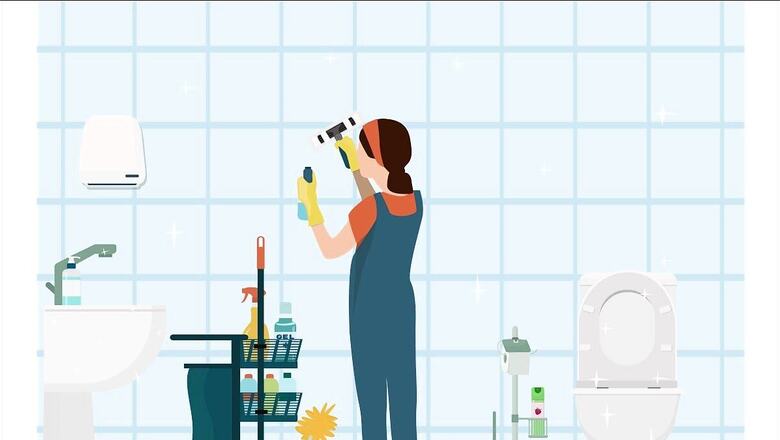
views
Come monsoon, and every parent has their guard up against the host of illnesses the season brings. Waterborne diseases abound – during the monsoon season, water accumulates everywhere and contaminates easily, heightening the risk of contracting such diseases.
The abundance of stagnant water provides a breeding ground for harmful bacteria, viruses, and parasites. Add to this, the threat posed by flooded and waterlogged toilets, and the pollution they create in the soil and water around them. They contaminate water sources, including wells, ponds, and even household water supplies, leading to a surge in waterborne illnesses. As children play in puddles, unaware of the potential danger lurking within, they become susceptible to infections.
Waterborne diseases can have severe consequences, not just for children whose immune systems are still developing but also for adults. These diseases can cause symptoms ranging from mild discomfort to life-threatening complications, putting public health and well-being at risk.
Poor Sanitation and Common Diseases
In India, children still succumb to waterborne diseases like Diarrhoea, Cholera, Typhoid, Amoebic Dysentery, Hepatitis A, Shigellosis, Giardiasis and many others. Every single one of these diseases is caused by ingestion of contaminated food or water, which then causes bacterial infections inside the body. In communities where toilet sanitation is a problem, or where municipal waste (which includes toilet wastes) is allowed to flow untreated into land and water masses, these diseases are increasingly common. In Cholera, the disease progresses rapidly, and can become fatal in a matter of hours. Typhoid fever can last for 3-4 weeks. A person with Hepatitis A feels better after a whopping 3 months, that too, after significant care and nutrition. Of these, Diarrhoea is the third most common cause of death in under-five children, responsible for 13% deaths in this age-group, killing an estimated 300,000 children in India each year.
Besides waterborne diseases, vector borne diseases like Malaria, Dengue Fever, Yellow fever, Chikungunya and others are common in areas where good toilet sanitation practices are not followed, and where sanitation facilities either do not exist, or are poorly maintained. Toilet sanitation isn’t just about cleaning the toilet bowl itself, but ensuring that the area surrounding it remains clean and dry. Any standing water attracts these vectors, and each of these diseases is caused by vectors who flourish in dirty standing water. Overflowing sewage is another common breeding ground.
Importance of Toilet Hygiene in Preventing Diseases
Preventing diseases requires a multi-faceted approach. One crucial aspect is addressing the issue of poor toilet hygiene. Inadequate sanitation practices contribute significantly to the contamination of water sources and the spread of diseases.
One of the main ways that water sources can get contaminated is through human faeces. When people do not have access to safe and clean toilets, or when toilets aren’t connected to proper drainage, human wastes can pollute the environment and the water sources that are used for drinking, cooking, bathing, or washing. During the monsoon season, the heavy rains can spread these wastes to nearby water sources, increasing the chances of infection. Toilets that get backed up, flooded or damaged also cause enormous pollution.
One of the most effective ways of preventing these waterborne diseases is by maintaining clean and safe toilets. When people use these toilets, and these toilets are connected to sewer systems, there is no contact between human faeces and water sources. The other factor that makes an enormous difference is practising good toilet hygiene – washing hands with soap after using the toilet, disposing sanitary products and diapers properly, and keeping the toilet area clean and dry.
Regular cleaning and disinfection of toilets and proper waste management significantly reduce the risk of contamination. Safe and clean toilets not only act as barriers, preventing pathogens from entering water sources and the food chain, but also keep vectors at bay, preventing vector borne diseases.
To ensure optimal toilet hygiene during the monsoon season, it is essential to follow certain best practices.
- Regularly clean toilets using appropriate disinfectants, such as Harpic.
- Pay attention to areas prone to moisture and mould.
- Keep toilet seats dry and maintain proper ventilation to minimise humidity.
- Dispose of waste properly and ensure septic tanks are well-maintained.
- Practise thorough handwashing with soap after using the toilet
One part of the solution here relates to infrastructure – providing enough toilets, and making sure that they are properly set up in terms of both water supply, as well as connection to sewer systems. The other, and possibly more significant part of the solution lies in changing the behaviour of users.
Role of Education in Promoting Toilet Hygiene
Much of the spread of these diseases can be blamed on ignorance. In rural areas and in urban slums, which combine a large population with a small number of toilets, and compound the problem with a lack of education, these diseases can run rampant.
Educating these individuals about toilet hygiene and diseases can help them understand the causes, symptoms, prevention, and treatment of these diseases. It can also help them adopt healthy habits and practices that can protect themselves and their families from infection. Down the road, these individuals can also feel empowered enough to demand better toilet and sanitation facilities from the authorities.
In India, the Swachh Bharat Mission has made a herculean effort towards both creating toilets and educating users. Thankfully, the GoI is not alone in this effort. Brands like Harpic, which is a leader in the lavatory care segment, have built strong communication strategies around the need for good toilet hygiene habits in particular, and sanitation overall. Harpic decided to take the lead in the sanitation and hygiene movement by creating innovative, thought provoking campaigns and outreach programs.
In addition to creating programming and communications aimed at adults, Harpic partnered with Sesame Workshop India, an educational non-profit working for the early developmental needs of young children, to promote positive sanitation, hygiene knowledge and behaviours among children and families through schools and communities, engaging with 17.5 million children across India. It also pioneered a programme to raise awareness and reinforce healthy toilet and bathroom habits among young children, developing and recognising them as “Swachhta Champions”. These initiatives are a part of the larger umbrella campaign, Harpic Mission Swachhta and Paani, with News18.
Mission Swachhta aur Paani is a movement that upholds the cause of inclusive sanitation where everyone has access to clean toilets. It advocates equality for all genders, abilities, castes and classes and strongly believes that clean toilets are a shared responsibility. Clean and safe toilets for all means that our communities are healthier, our children spend more days in school and less days out sick, girls don’t drop out of school, our workplaces are more diverse places, and that our cities and towns are cleaner, safer, and more welcoming.
Mission Swachhta aur Paani is in its third year now, and in addition to serving as a platform for stakeholders from various fields to come together in thought, word and action, also serves as a repository of information that helps you have the right conversations with the right parties. Whether it is educating your children about toilet etiquette, or learning how you can talk to your local municipal ward officer about getting your local public toilets upgraded – Mission Swacchta aur Paani has the information you need to make an impactful argument.
Join us here, to learn how you can contribute to this national conversation, and pave the way to a Swasth Bharat, and a Swachh Bharat.




















Comments
0 comment